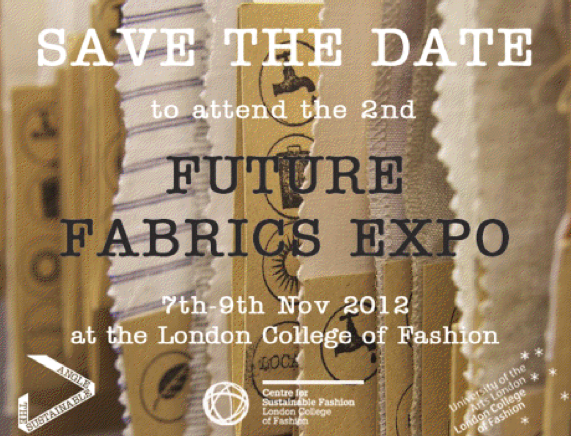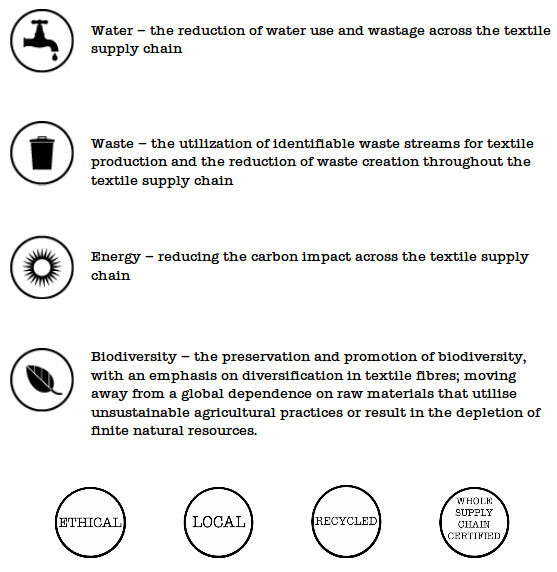
The second Future Fabrics Expo was hosted at the London College of Fashion on November 7th – 9th 2013, and was attended by a rather large number designers, buyers and students. Roughly 650 fabrics with a reduced environmental impact stemming from around 50 textile mills world-wide, were showcased, along with inspirational and/or interactive videos and information panels.
By looking deeper into the fashion and textile supply chain, in order to drive forward the discussion on sustainability, The second edition provided an even more inspiring and informative experience than the first edition. It managed to demonstrate that responsible fashion design indeed does go much beyond ‘just’ using sustainable fabrics.
Future Fabrics Expo: Background and Aim
The exhibition was organised for the second time by The Sustainable Angle (TSA), a UK-Swiss non-for-profit organisation whose mission it is to initiate and support projects which contribute to minimising the environmental impact of industry and society.
Their Future Fabrics Expo project focuses on the fashion industry and how its environmental, to some extent also social, impact can be lowered through innovation in the textile industry, and novel ideas to transform the fashion system and design practice. Its intent is to inform and inspire current and soon-to-be fashion designers and buyers about the variety, availability and viability of sustainable fabrics, to spread the knowledge about the use of sustainable textiles in fashion, and to change how these fabrics are perceived in the fashion industry overall. To achieve that, the organisation works in a variety of ways – both, hands-on as well as conceptually.
Consequently, key efforts go into tracking down fabrics that live up to the quality promises that high-end fashion designers expect. With this type of fabrics at hand, designers and buyers are willing and happy to learn about how these fabrics have been produced, and in what way they are different, better, than what is available to them ‘off the peg’.
It is in this way hence, that fashion designers are informed and updated about the existence of trends relevant and high quality sustainable textile options currently available, and that are suitable for mid- to high-end fashion brands.
Further, when designers are habitually used to be presented with only tiny fabric swatches to ascertain the suitability of a fabric for their purpose, TSA offers them the opportunities to access sample fabrics instead. As this allows the designers to experience drape and feel of a fabric, they immediately develop confidence in that the fabric performs just as they require.
Another important aspect of the Expo’s role is the sensibilisation of designers, and to encourage them to be open for ideas that go beyond materials, and impact their whole supply chain, their own design practise, and the fashion system – habits, traditions, state-of-the-art approaches – within which they are building their brand.
Finally, the TSA’s educational role cannot be underestimated – not only for students but also from for professionals within the industry: from buyers and category buyers, to brand designers, range managers and merchandisers. In the case of mainstream retailers, these responsibles are sometimes not sufficiently familiar with textiles overall, the quality, performance and production difference that come with the different fabric types. The fact that large luxury brands such as Gucci are in the initial phase of building their own sustainable fabrics library shows that this education aspect is indeed of relevance, and that there is an opportunity window whereby these brands will be able to influence and engage with their second-tier suppliers.
Selection Criteria
When evaluating the fabrics, and the producing mill, to be included in their exhibition, TSA focuses primarily on the environmental criteria detailed in Illustration 1. Equally important are quality, aesthetics and suitability for both fashion and function, as well ethical and local production, recycled materials, and entirely certified supply chains.

Future Fabrics year ’round
TSA’s activities do not stop with the organisation of the yearly Future Fabrics Expo, however. In addition, the organisation act as a marketing channel for suppliers, presenting products to key industry members and press, for instance. On appointment, the full range of fabrics is available to be viewed and touched in their small, effectively organised show room in North Notting Hill, London, and their experts are available to assist designers and brands in their efforts to source more sustainable fabrics. The Expo – either as a whole, or only for a subset of specific fabrics – is also available on appointment as in-house event for medium to large brands.
Information for interested fabric mills:
Fabrics and mill credentials, and the verification to the environmental criteria outline above, are subject to a rolling application and thorough review throughout the year.
The Sustainable Angle requires interested fabric mills to send samples as well as detailed production/certification information with all submissions.
The current range of fabrics represented by TSA stems from mills across the whole globe: Europe, the Americas, as well as Asia and Africa.
Further supplier documentation can be download from here.
Save the date:
The Future Fabrics Expo will be making its third appearance in Copenhagen, Denmark on 8th – 10th September 2013. The expo will be part of a newly established commercial fair, the biggest sustainable fabrics fair in the world.
Pictures available from ((c) The Sustainable Angle):
http://www.thesustainableangle.org/futurefabricsexpo/Photos/FutureFabricsExpo2012.aspx

